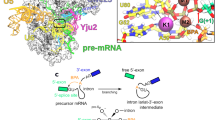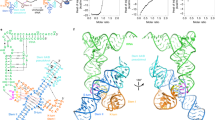Abstract
Metal ions are essential for the folding and activity of large catalytic RNAs. While divalent metal ions have been directly implicated in RNA tertiary structure formation, the role of monovalent ions has been largely unexplored. Here we report the first specific monovalent metal ion binding site within a catalytic RNA. As seen crystallographically, a potassium ion is coordinated immediately below AA platforms of the Tetrahymena ribozyme P4-P6 domain, including that within the tetraloop receptor. Interference and kinetic experiments demonstrate that potassium ion binding within the tetraloop receptor stabilizes the folding of the P4-P6 domain and enhances the activity of the Azoarcus group I intron. Since a monovalent ion binding site is integral to the tetraloop receptor, a tertiary structural motif that occurs frequently in RNA, monovalent metal ions are likely to participate in the folding and activity of a wide diversity of RNAs.
This is a preview of subscription content, access via your institution
Access options
Subscribe to this journal
Receive 12 print issues and online access
$189.00 per year
only $15.75 per issue
Buy this article
- Purchase on Springer Link
- Instant access to full article PDF
Prices may be subject to local taxes which are calculated during checkout




Similar content being viewed by others
References
Pyle, A.M. Ribozymes: a distinct class of metalloenzymes. Science 261, 709–714 (1993).
Pyle, A.M. Catalytic reaction mechanisms and structural features of group II intron ribozymes. in Catalytic RNA, Vol. 10 (eds Eckstein, F. & Lilley, D.M.J.) 75–107 (Springer, New York; 1996).
Nolan, J.M. & Pace, N.R. Structural analysis of the bacterial ribonuclease P RNA. in Catalytic RNA, Vol. 10 (eds. Eckstein, F. & Lilley, D.M.J.) 109–128 (Springer, New York; 1996).
Miskin, R., Zamir, A. & Elson, D. Inactivation and reactivation of ribosomal subunits: the peptidyl transferase activity of the 50S subunit of Escherichia coli. J. Mol. Biol. 54, 355– 378 (1970).
Zamir, A., Miskin, R. & Elson, D. Inactivation and reactivation of ribosomal subunits: amino acyl-transfer RNA binding activity of the 30S subunit of Escherichia coli. J. Mol. Biol. 60, 347– 364 (1971).
Manning, G.S. The molecular theory of polyelectrolyte solutions with applications to the electrostatic properties of polynucleotides. Quart. Rev. Biophys. 2, 179–246 ( 1978).
Costa, M. & Michel, F. Frequent use of the same tertiary motif by self-folding RNAs. EMBO J. 14, 1276–1285 (1995).
Cate, J.H. et al. Crystal structure of a group I ribozyme domain: principles of RNA packing. Science 273, 1678– 1685 (1996).
Cate, J.H. et al. RNA tertiary structure mediation by adenosine platforms. Science 273, 1696–1699 (1996).
Murphy, F.L. & Cech, T.R. GAAA tetraloop and conserved bulge stabilize tertiary structure of a group I intron domain. J. Mol. Biol. 236, 49–63 ( 1994).
Cate, J.H., Hanna, R.L. & Doudna, J.A. A magnesium ion core at the heart of a ribozyme domain. Nature Struct. Biol. 4, 553– 558 (1997).
Cate, J.H. & Doudna, J.A. Metal-binding sites in the major groove of a large ribozyme domain. Structure 4, 1221–1229 (1996).
Pauling, L. The Nature of the Chemical Bond, (Cornell University Press, Ithaca, NY, 1960).
Gaur, R.K. & Krupp, G. Modification interference approach to detect ribose moieties important for the optimal activity of a ribozyme. Nucleic Acids Res. 21, 21– 26 (1993).
Strobel, S.A. & Shetty, K. Defining the chemical groups essential for Tetrahymena group I intron function by nucleotide analog interference mapping. Proc. Natl. Acad. Sci. USA 94, 2903–2908 (1997).
Pearson, R.G. Acids and Bases. Science 151, 172– 177 (1966).
Heitner, H.I., Lippard, S.J. & Sunshine, H.R. Metal binding by thionucleosides. J. Amer. Chem. Soc. 94, 8936–8937 (1972).
Gish, G. & Eckstein, F. DNA and RNA sequence determination based on phosphorothioate chemistry. Science 240, 1520–1522 (1988).
Boeyens, J.C.A. & Herbstein, F.H. Ionic complexes of thiourea. II. Chemical and crystallographic survey and determination of the crystal structures of some representative complexes. Inorg. Chem. 6, 1408–1425 ( 1967).
Ortoleva-Donnelly, L., Szewczak, A.A., Gutell, R.R. & Strobel, S.A. The chemical basis of adenosine conservation throughout the Tetrahymena ribozyme. RNA 4, 498– 519 (1998).
Reinhold-Hurek, B. & Shub, D.A. Self-splicing introns in tRNA genes of widely divergent bacteria. Nature 357, 173–176 (1992).
Tanner, M.A. & Cech, T.R. Activity and thermostability of the small self-splicing group I intron in the pre-tRNAlle of the purple bacterium Azoarcus. RNA 2, 74–83 (1996).
Beaudry, A.A. & Joyce, G.F. Directed evolution of an RNA enzyme. Science 257, 635–641 (1992).
Michel, F., Hanna, M., Green, R., Bartel, D.P. & Szostak, J.W. The guanosine binding site of the Tetrahymena ribozyme. Nature 342, 391– 395 (1989).
Michel, F., Ellington, A.D., Couture, S. & Szostak, J.W. Phylogenetic and genetic evidence for base-triples in the catalytic domain of group I introns. Nature 347, 578– 580 (1990).
Pecoraro, V.L., Hermes, J.D. & Cleland, W.W. Stability constants of Mg2+ and Cd2+ complexes of adenine nucleotides and thionucleotides and rate constants for formation and dissociation of MgATP and MgADP. Biochemistry 23, 5262–5271 ( 1984).
Villeret, V., Huang, S., Fromm, H.J. & Lipscomb, W.N. Crystallographic evidence for the action of potassium, thallium, and lithium on fructose-1,6-bisphosphatase. Proc. Natl. Acad. Sci. USA 92, 8916– 8920 (1995).
Wilbanks, S.M. & McKay, D.B. How potassium affects the activity of the molecular chaperone Hsc70. II. Potassium binds specifically in the ATPase active site. J. Mol. Biol. 270, 2251–2257 (1995).
Doyle, D.A. et al. The structure of the potassium channel: molecular basis of K+ conduction and selectivity. Science 280, 69–77 (1998).
Rosenberg, J.M. et al. Double helix at atomic resolution. Nature 243, 150–154 ( 1973).
Williamson, J.R., Raghuraman, M.K. & Cech, T.R. Monovalent cation-induced structure of telomeric DNA: the G-quartet model. Cell 59, 871– 880 (1989).
Cheong, C. & Moore, P.B. Solution structure of an unusually stable RNA tetraplex containing G- and U-quartet structures. Biochemistry 31, 8406–8414 ( 1992).
Laughlan, G. et al. The high resolution crystal structure of a parallel-stranded guanine tetraplex. Nature 265, 520– 524 (1994).
Sundquist, W.I. & Heaphy, S. Evidence for interstrand quadruplex formation in the dimerization of human immunodeficiency virus 1 genomic RNA. Proc. Natl. Acad. Sci. USA 90, 3393–3397 (1993).
Wang, Y.-W., Lu, M. & Draper, D.E. Specific ammonium ion requirement for functional ribosomal RNA tertiary structure. Biochemistry 32, 12279–12282 (1993).
Cox, B.G. & Schneider, H. Coordination and Transport Properties of Macrocyclic Compounds in Solution (Elsevier Science Publishers, New York; 1992).
Brown, I.B. What factors determine cation coordination numbers? Acta Crystallogr. B 44, 545–553 ( 1988).
Hinton, J.F., Turner, G. & Millett, F.S. Thallous ion interaction with gramicidin incorporated in micelles studied by thallium-205 NMR. Biochemistry 21, 651–654 (1982).
Hinton, J.F., Whaley, W.L., Shungu, D., Koeppe, R.E. & Millett, F.S. Equilibrium binding constants for the group I metal cations with gramicidin-A determined by competition studies and Tl+-205 nuclear magnetic resonance spectroscopy. Biophys. J. 50, 539–544 (1986).
Doudna, J.A., Grosshans, C., Gooding, A. & Kundrot, C.E. Crystallization of ribozymes and small RNA motifs by a sparce matrix approach. Proc. Natl. Acad. Sci. USA 90, 7829 (1993).
Arabshahi, A. & Frey, P.A. A simplified procedure for synthesizing nucleoside 1-thiotriphosphates: dATPαS, dGTPαS, UTPαS, and dTTPαS. Biochem. Biophys. Res. Com. 204, 150–155 (1994).
Fox, J.J., Wempen, I., Hampton, A. & Doerr, I.L. Thiation of nucleosides. I. Synthesis of 2-amino-6-mercapto-9-ß-D-ribofuranosylpurine ("thioguanosine") and related purine nucleosides. J. Org. Chem. 80, 1669–1675 (1957).
Lingner, J. & Keller, W. 3'-end labeling of RNA with recombinant yeast poly(A) polymerase. Nucleic Acids Res. 21, 2917–2920 (1993).
Carson, M. RIBBONS 2.0 J. Appl. Crystallogr. 47, 110 (1991).
Acknowledgements
We wish to thank P. B. Moore and J. R. Williamson for critical comments on the manuscript. R.P.R. and J.H.C. were supported by the NIH and A.R.F is a Fellow of the Jane Coffin Childs Memorial Fund for Medical Research. J. S.-S. is a Fellow of the NIH. S.A.S. and J.A.D. are both supported by Beckman Young Investigator Awards and the Searle Foundation. J.A.D. is a Lucille P. Markey Scholar and a David and Lucile Packard Foundation Fellow. This work was funded by an NSF CAREER award and a JFRA from the ACS to S.A.S., and by an NIH grant to J.A.D.
Author information
Authors and Affiliations
Corresponding authors
Rights and permissions
About this article
Cite this article
Basu, S., P. Rambo, R., Strauss-Soukup, J. et al. A specific monovalent metal ion integral to the AA platform of the RNA tetraloop receptor. Nat Struct Mol Biol 5, 986–992 (1998). https://doi.org/10.1038/2960
Received:
Accepted:
Issue Date:
DOI: https://doi.org/10.1038/2960
This article is cited by
-
Crystal structure of a eukaryotic group II intron lariat
Nature (2014)
-
Mass Spectrometric Study on Sodium Ion Induced Central Nucleotide Deletion in the Gas Phase
Journal of the American Society for Mass Spectrometry (2012)
-
Enhancing the Prebiotic Relevance of a Set of Covalently Self-Assembling, Autorecombining RNAs Through In Vitro Selection
Journal of Molecular Evolution (2010)
-
Structural insights into amino acid binding and gene control by a lysine riboswitch
Nature (2008)



